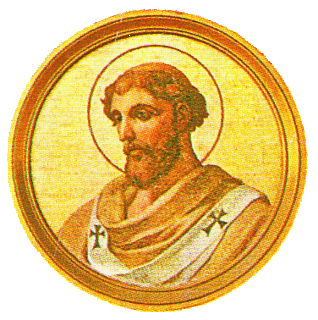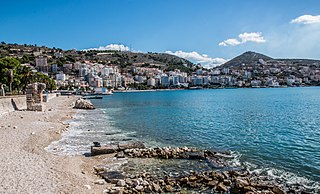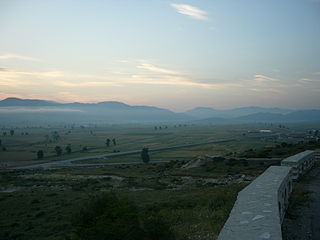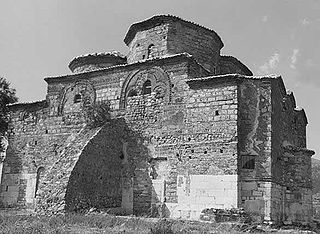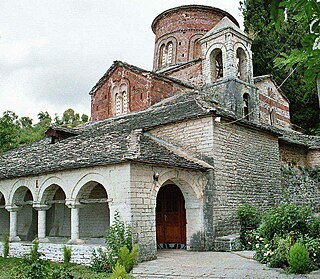Saint Donatus | |
|---|---|
| Born | Butrint |
| Venerated in | Eastern Orthodox Church [1] Roman Catholic Church [2] |
| Major shrine | Kassiopi in Corfu, modern Greece |
| Feast | April 30 |
Saint Donatus of Evorea (Albanian : Shën Donati, Greek : Άγιος Δονάτος) [3] was a Christian saint revered in Albania and Greece.

Albanian is an Indo-European language spoken by the Albanians in the Balkans and the Albanian diaspora in the Americas, Europe and Oceania. It comprises an independent branch within the Indo-European languages and is not closely related to any other language in Europe.

Greek is an independent branch of the Indo-European family of languages, native to Greece, Cyprus and other parts of the Eastern Mediterranean and the Black Sea. It has the longest documented history of any living Indo-European language, spanning more than 3000 years of written records. Its writing system has been the Greek alphabet for the major part of its history; other systems, such as Linear B and the Cypriot syllabary, were used previously. The alphabet arose from the Phoenician script and was in turn the basis of the Latin, Cyrillic, Armenian, Coptic, Gothic, and many other writing systems.

Greece, officially the Hellenic Republic, historically also known as Hellas, is a country located in Southern and Southeast Europe, with a population of approximately 11 million as of 2016. Athens is the nation's capital and largest city, followed by Thessaloniki.
Donatus was born in Butrint, Chaonia, (modern southern Albania), and lived during the reign of the Emperor Theodosius I. According to the 5th-century Greek historian Sozomen, Saint Donatus was Bishop of Evorea, identifiable with Paramythia in Epirus, Greece. The saint is said to have accomplished several miracles, such as successfully fighting a dragon, purifying well waters, saving the emperors' daughter, and reviving the dead. [3]
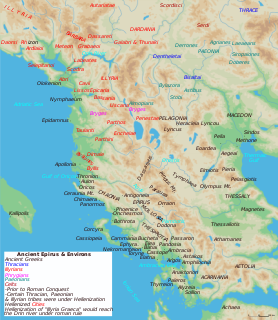
Chaonia or Chaon was the name of the northwestern part of Epirus, the homeland of the Greek tribe of the Chaonians. Its main town was called Phoenice. According to Virgil, Chaon was the eponymous ancestor of the Chaonians.

Theodosius I, also known as Theodosius the Great, was a Roman Emperor from 379 to 395, and the last emperor to rule over both the Eastern and the Western halves of the Roman Empire. On accepting his elevation, he campaigned against Goths and other barbarians who had invaded the Empire. His resources were not sufficient to destroy them or drive them out, which had been Roman policy for centuries in dealing with invaders. By treaty, which followed his indecisive victory at the end of the Gothic War, they were established as foederati, autonomous allies of the Empire, south of the Danube, in Illyricum, within the Empire's borders. They were given lands and allowed to remain under their own leaders, a grave departure from Roman hegemonic ways. This turn away from traditional policies was accommodationist and had grave consequences for the Western Empire from the beginning of the century, as the Romans found themselves with the impossible task of defending the borders and deal with unruly federates within. Theodosius I was obliged to fight two destructive civil wars, successively defeating the usurpers Magnus Maximus in 387-388 and Eugenius in 394, though not without material cost to the power of the Empire.
Salminius Hermias Sozomenus, also known as Sozomen was a historian of the Christian Church.
Saint Donatus of Butrint died in 387 and his remains were transferred to Kassiopi in Corfu in 602 in order to be saved from barbarian invasions. However this led to a problem of jurisdiction and custody for the holy relics, which was resolved by Pope Gregory I. Donatus's cult was widespread in the Middle Ages. [3]
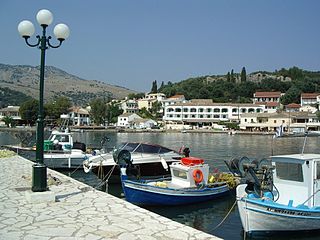
Kassiopi is a village, and a resort on the affluent north east coast of Corfu. It is in the municipal unit of Kassopaia. Historically, a small traditional fishing village, the town itself has been heavily developed and with more luxury villas now outside it, but it remains a summer social centre heavily visited by tourists, particularly popular with visitors from Britain and Italy.
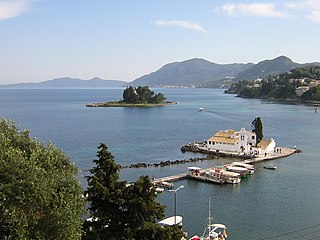
Corfu or Kerkyra is a Greek island in the Ionian Sea. It is the second largest of the Ionian Islands, and, including its small satellite islands, forms the northwesternmost part of Greece. The island is part of the Corfu regional unit, and is administered as a single municipality, which also includes the smaller islands of Ereikoussa, Mathraki and Othonoi. The municipality has an area of 610,9 km2, the island proper 592,8 km2. The principal city of the island and seat of the municipality is also named Corfu. Corfu is home to the Ionian University.

Pope Gregory I, commonly known as Saint Gregory the Great, was Pope of the Catholic Church from 3 September 590 to 12 March 604 AD. He is famous for instigating the first recorded large-scale mission from Rome, the Gregorian Mission, to convert the then-pagan Anglo-Saxons in England to Christianity. Gregory is also well known for his writings, which were more prolific than those of any of his predecessors as Pope. The epithet Saint Gregory the Dialogist has been attached to him in Eastern Christianity because of his Dialogues. English translations of Eastern texts sometimes list him as Gregory "Dialogos", or the Anglo-Latinate equivalent "Dialogus".
His feast day is April 30. [3]
Umbriatico Cathedral in Calabria in the south of Italy is dedicated to him: the area was occupied by Epirote troops after the conquest of Nikephoros Phokas the Elder in the 9th century, who brought with them the cults of the saints familiar to them. [4]

Calabria, known in antiquity as Bruttium, is a region in Southern Italy.

Italy, officially the Italian Republic, is a country in Southern and Western Europe. Located in the middle of the Mediterranean Sea, Italy shares open land borders with France, Switzerland, Austria, Slovenia and the enclaved microstates San Marino and Vatican City. Italy covers an area of 301,340 km2 (116,350 sq mi) and has a largely temperate seasonal and Mediterranean climate. With around 61 million inhabitants, it is the fourth-most populous EU member state and the most populous country in Southern Europe.
Nikephoros Phokas, usually surnamed the Elder to distinguish him from his grandson, Emperor Nikephoros II Phokas, was one of the most prominent Byzantine generals of the late 9th century, and the first important member of the Phokas family. As a youth he was taken into the personal retinue of Emperor Basil I the Macedonian, rising quickly to the posts of protostrator and then governor of Charsianon, whence he fought with success against the Arabs. In ca. 886 he led a major expedition in southern Italy, where his victories laid the foundation for the Byzantine resurgence in the peninsula. After his return, he was raised to the post of Domestic of the Schools, in effect commander-in-chief of the army, which he led with success against the Arabs in the east and the Bulgarians of Tsar Simeon in the Balkans. He died either in 895/6 or, less likely, sometime ca. 900. Contemporaries and later historians lauded him for his military ability and character. Both of his sons later succeeded him as Domestics of the Schools. His grandsons Nikephoros and Leo were likewise distinguished generals, while the former became emperor in 963–969, spearheading the recovery of several lost provinces from the Arabs.

